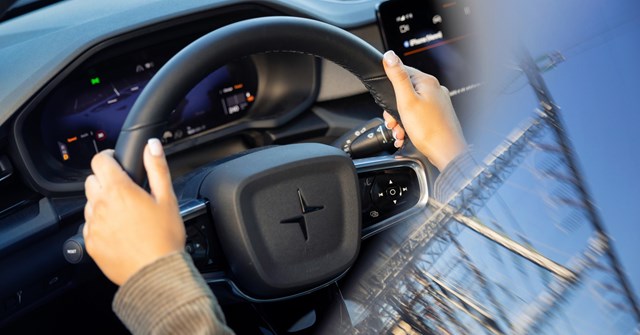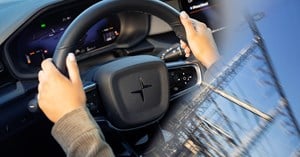Charging an electric vehicle at home
Safety, convenience, and cost-effectiveness are key reasons to opt for a home charging station. Check with Oulun Energia Sähköverkko Oy to ensure the durability of the electric power system and assess any potential capacity limitations before ordering installation work. The work begins with a survey and an electrical plan made by the electrical designer, after which requests for tender are sent to electrical contractors for the installation of the charging stations.
How do you charge an electric vehicle?
Charging an electric vehicle (EV) is fast and safe with an appropriate wall- or pole-mounted charging station. Charging time varies from one to about eight hours, depending on battery capacity and current charge level.
You can even charge the battery of an EV after each use—no need to wait for the battery to run out. Partial charging does not adversely affect battery life. The device ensures correct connection to the electric power network, as well as protects against overload and electric shock. Charging stops automatically when the battery is full.
Electric vehicles can only be temporarily charged from a regular outlet. Charging using a regular outlet is time-consuming, as the energy transfer rate in a household outlet is not particularly high compared to a charging station. Slow charging may also be a fire safety hazard.
Public charging stations, such as petrol stations, offer rapid charging that charges the battery to 80% in 15–30 minutes. However, it is good to remember that not all cars are suitable for rapid charging. For example, many hybrids cannot use rapid charging.
A charging station for your own home
An EV charging station can be installed in your own yard, garage, or carport, or in a housing cooperative parking lot. From a housing cooperative’s point of view, a charging station can be an attractive investment that increases the appeal and resale value of the apartments. It is more cost-effective to carry out the installation of charging stations as a joint procurement through the housing cooperative.
Acquiring an EV charging station often begins with a survey carried out by an electrical designer or a company that sells charging stations, who will determine the capacity of the property’s current electrical equipment. If you live in a housing cooperative, you should start by contacting the property manager, who can explore charging possibilities for the whole housing cooperative.
Once the electric power system’s durability has been verified, the most suitable charging station for both the property and vehicle can be selected. The device is then configured to match the available electrical capacity. A charging station with dynamic load management allocates the charging power to prevent overloading the main fuses. This means that car charging is paused when, for example, heating a sauna stove. Charging an EV at night reduces peak loads.
Charging stations always operate on their own circuit, ensuring that the charger does not overload other electrical wiring. A separate cable is run from the main or sub-distribution switchboard to the charging station. When installing, it is therefore important to consider the location of the charging station and its distance from the main switchboard—this also affects costs.
The electricity network distributor will modify the electricity connection
The main switchboard of a modern property typically supports the installation of a single charging station. However, if an increase in fuse rating is necessary, the electricity network distributor will invoice the customer for the difference between the connection fees for the new main fuse rating and the current main fuse rating. If an increase in the main fuse rating is required to accommodate electric vehicle charging, the customer must request a modification of the permanent connection. Oulun Energia’s customers can request a connection modification here.
Housing cooperatives may opt to purchase a new connection, in which case the network distributor will charge a connection fee based on the main fuse rating of the connection. If you are a customer and want to inquire about the current rating of your electricity connection, or the schedule or cost of an additional connection fee for increasing the connection, please contact our technical support.
Examples of the most common network distributor connection upgrade fees
| Modification of electricity connection | Price |
| Fuse rating increases from 3x25 -> 3x35A (Zone 1* & 2*) |
€230 |
| Fuse rating increases from 3x25 -> 3x35A and the main distribution board is also upgraded accordingly (Zone 1* & 2*) |
€324,15 |
| Fuse rating increases from 1x25A -> 3x25A (Zone 1*) |
€575 |
| Fuse rating increases from 1x25A -> 3x25A (Zone 2*) |
€1,850 |
*Zone 1 = Includes areas defined by the town plan and connection points situated within 50 metres of the town plan boundary.
*Zone 2 = Areas located outside the town plan boundary, provided that their connection point is located no more than 600 metres of an existing distribution substation and the main fuse rating does not exceed 3x250A.
Why choose an EV charging station for your home?
Safety
A modern charging station is safe for both the property and the vehicle. This requires that the charging station is correctly rated and that the installation is performed by a qualified electrical engineer.
Convenience
A charging station is convenient and simple to use. It is significantly faster than an engine heater cable connected to a heater plug or an outdoor outlet.
Cost effectiveness
With your own charging station, you can optimise your electricity consumption. Consumers using exchange electricity or solar energy can schedule electric charging to occur during periods of lower electricity rates.
Key considerations for installing an EV charging station

Initial survey of the electricity connection
If there is any uncertainty regarding the adequacy of the current main fuses for the installation of an EV charging station, the electrical designer or customer can request the connection’s consumption and peak power data from technical support. The electrical designer will use this data to determine the appropriate main fuse rating.

Suitability of the main switchboard
The electrical contractor responsible for the connection must ensure that the rated current (In) of the main switchboard matches the main fuse rating of the new connection. If the rated current of the main switchboard is insufficient and the customer wishes to increase the main fuse rating of the connection, the main switchboard will need to be replaced. Replacements of main switchboards are performed by electrical contractors.

Suitability of the connection cable
The customer’s connection cable must be able to withstand the increase in the main fuse rating, considering the installation method of the cable and the load reduction factors in accordance with standard SFS-6000. If the connection cable is insufficient to support the increased main fuse rating, the customer is responsible for the excavation work to lay a new connection cable from the connection point to the main switchboard. The connection point is typically located at the property boundary. Please contact technical support for the exact location of the connection point.

Oulun Energia mobile app
Monitoring your own energy consumption, Oulun Energia’s news feed, and monitoring the price of exchange electricity—these are some of the features that can be found in Oulun Energia’s updated mobile application.
Learn more!



